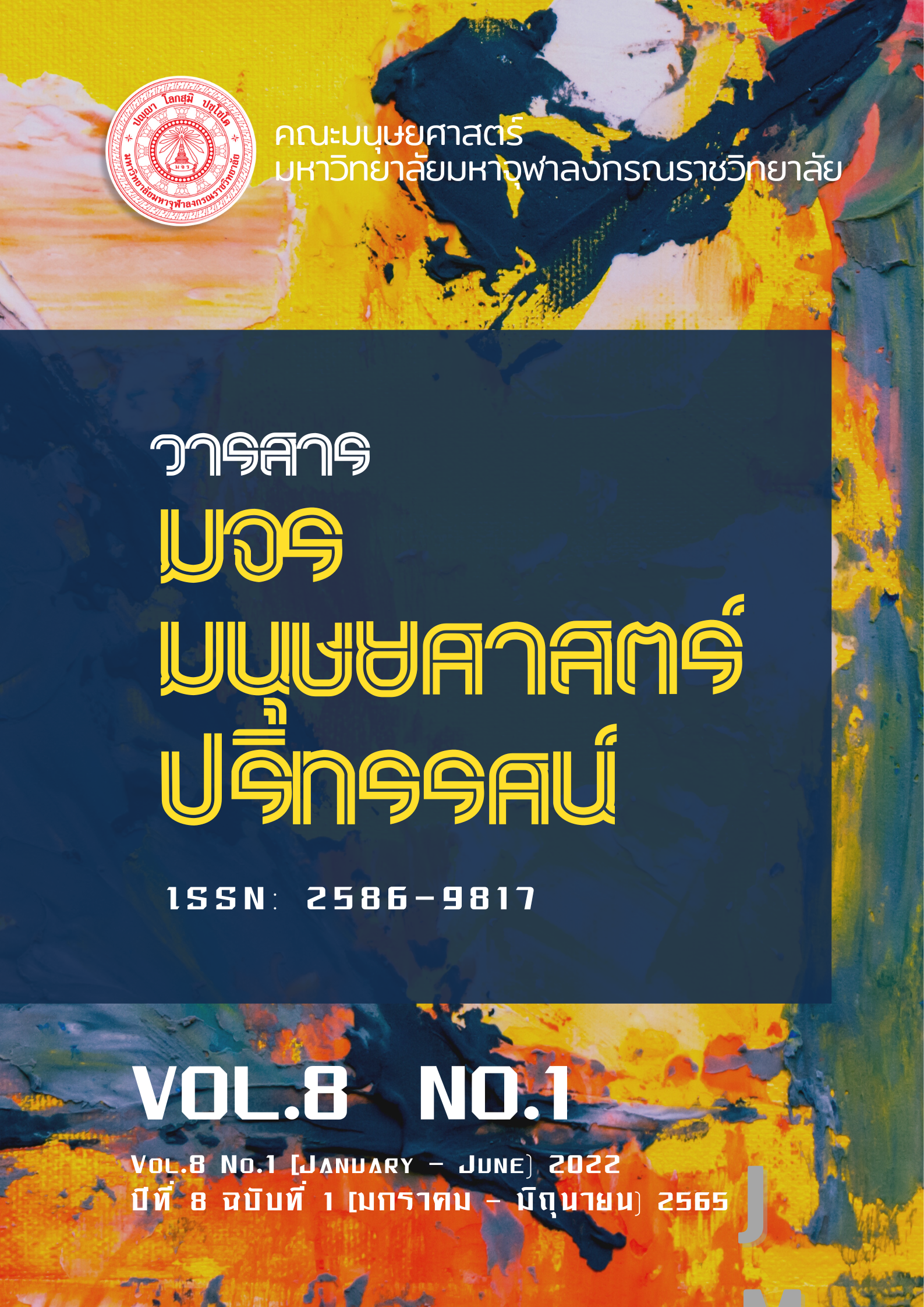ผลของการจัดกิจกรรมการเรียนรู้แบบอริยสัจ 4 ที่มีต่อความสามารถ ในการคิดอย่างมีวิจารณญาณและผลสัมฤทธิ์ทางการเรียน ของนักเรียนระดับมัธยมศึกษาปีที่ 3
คำสำคัญ:
การเรียนรู้แบบอริยสัจ 4, การคิดอย่างมีวิจารณญาณ, ผลสัมฤทธิ์ทางการเรียนบทคัดย่อ
การวิจัยครั้งนี้เป็นการวิจัยเชิงทดลองเบื้องต้น (Pre Experimental Design) มีวัตถุประสงค์เพื่อ 1) เปรียบเทียบผลสัมฤทธิ์ทางการเรียนของนักเรียน 2) เปรียบเทียบความสามารถทางการคิดอย่างมีวิจารณญาณ และ 3) ศึกษาระดับความพึงพอใจของนักเรียนชั้นมัธยมศึกษาปีที่ 3 ที่เรียนด้วยวิธีการเรียนรู้แบบอริยสัจ 4 กลุ่มตัวอย่างที่ใช้ในการวิจัยครั้งนี้ ได้แก่ นักเรียนชั้นมัธยมศึกษาปีที่ 3 โรงเรียนวัดจันทราวาส ตำบลกระจัน อำเภออู่ทอง จังหวัดสุพรรณบุรี ได้มาโดยวิธีการเลือกแบบเจาะจง จำนวน 11 คน เครื่องมือที่ใช้ในการวิจัย ได้แก่ 1) ชุดกิจกรรมการเรียนรู้แบบอริยสัจ 4 วิชาพระพุทธศาสนา เรื่อง พุทธปณิธาน 4 จำนวน 4 ชุด 2) แบบวัดผลสัมฤทธิ์ทางการเรียน 3) แบบวัดความสามารถในการคิดมีวิจารณญาณ และ 4) แบบสอบถามความพึงพอใจของนักเรียนชั้นมัธยมศึกษาปีที่ 3 ที่เรียนด้วยวิธีการเรียนรู้แบบอริยสัจ 4 วิเคราะห์ข้อมูลด้วยสถิติ ค่าเฉลี่ย ส่วนเบี่ยงเบนมาตรฐาน และการทดสอบค่า t-test dependent
ผลการวิจัยพบว่า
1) นักเรียนที่เรียนรู้แบบอริยสัจสี่ มีผลสัมฤทธิ์ทางการเรียนหลังเรียนสูงกว่าก่อนเรียน อย่างมีนัยสำคัญทางสถิติที่ระดับ .05 เนื่องจากวิธีการสอนแบบอริยสัจสี่เป็นกระบวนการแสวงหาความรู้ที่นักเรียนพยายามคิดค้นวิธีการแก้ปัญหาและวิธีการพัฒนาทักษะชีวิต โดยใช้ลำดับขั้นตอนของอริยสัจ 4 เป็นแนวทางการแก้ปัญหาและวิธีการพัฒนาทักษะชีวิตด้วยตนเอง เป็นการจัดการเรียนการสอนที่เน้นนักเรียนเป็นสำคัญ
2) ความสามารถในการคิดอย่างมีวิจารณญาณของนักเรียนที่เรียนรู้แบบอริยสัจ หลังเรียนสูงกว่าก่อนเรียน อย่างมีนัยสำคัญทางสถิติที่ระดับ .05 เนื่องจากนักเรียนได้เรียนรู้จากสถานการณ์ที่เกิดขึ้นในชีวิตประจำวัน ได้ศึกษาสถานการณ์ เริ่มกำหนดประเด็นปัญหา ร่วมกันพิจารณาจากข้อมูล มีการถกเถียงเพื่อกำหนดปัญหา ร่วมกันให้ความหมายของปัญหา การรวบรวมข้อมูลจากสถานการณ์จำลอง ร่วมกันพิจารณาความน่าเชื่อถือของข้อมูล ซึ่งเป็นกระบวนการพัฒนาความสามารถในการคิดอย่างมีวิจารณญาณ และ
3) นักเรียนมีความพึงพอใจต่อการเรียนรู้แบบอริยสัจสี่อยู่ในระดับมากอย่างมีนัยสำคัญทางสถิติที่ระดับ .05 เนื่องจากนักเรียนรู้สึกว่าได้สัมผัสกับสถานการณ์ที่เป็นปัญหาจากแบบฝึกทักษะหลายรูปแบบในเรื่อง พุทธปณิธาน 4 เป็นเรื่องที่สร้างแรงจูงใจให้อยากรู้ และท้าทายความสามารถในการคิดแก้ปัญหา(ขั้นทุกข์) ร่วมกันค้นคิดหาสาเหตุของปัญหาภายใต้มุมมองที่เป็นอิสระ (สมุทัย) นักเรียนร่วมกันรวบรวมข้อมูลเพื่อสนับสนุนทางเลือกที่ตนเองนำเสนอให้กับกลุ่ม (นิโรธ) ร่วมกันตัดสินใจเลือกและปฏิบัติด้วยรูปแบบที่ดีที่สุดในการแก้ปัญหาที่เป็นสาเหตุแห่งทุกข์ (มรรค)
เอกสารอ้างอิง
กระทรวงศึกษาธิการ. (2552). หลักสูตรแกนกลางการศึกษาขั้นพื้นฐานพุทธศักราช 2551. กรุงเทพฯ : ชุมนุมสหกรณ์การเกษตรแห่งประเทศไทย.
กิตติชัย สุธาสิโนบล. (2564). การจัดการเรียนการสอนพระพุทธศาสนาที่เหมาะสมกับผู้เรียนในสังคมไทยยุคปัจจุบัน. สืบค้น 12 สิงหาคม 2564, จาก https://www. facebook.com/krupramahachula/posts/
ดำรงศักดิ์ สุดเสน่ห์. (2561). กระบวนการสร้างเสริมศักยภาพการคิดอย่างมีวิจารณญาณของนักเรียนในศตวรรษที่ 21 ตามธรรมชาติวิชาวิทยาศาสตร์ (รายงานการวิจัย). กรุงเทพฯ : สำนักงานคณะกรรมการการศึกษาขั้นพื้นฐาน กระทรวงศึกษาธิการ.
ทิศนา แขมมณี. (2545). ศาสตร์การสอน. กรุงเทพฯ : สำนักพิมพ์แห่งจุฬาลงกรณ์มหาวิทยาลัย.
ศันสนีย์ ฉัตรคุปต์ และอุษา ชูชาติ. (2544). ฝึกสมองให้คิดอย่างมีวิจารณญาณ. กรุงเทพฯ : วัฒนาพานิช.
สุมน อมรวิวัฒน์. (2530). การสอนโดยสร้างศรัทธาและโยนิโสมนสิการ. กรุงเทพฯ : โรงพิมพ์ โอ.เอส.พริ้นติ้ง เฮ้าส์.
สุรพล พรมกุล. (2554). ระเบียบวิธีวิจัยทางรัฐศาสตร์. กรุงเทพฯ : โอเดียนสโตร์.
สุชิลา สวัสดี. (2560). การพัฒนารูปแบบการจัดการเรียนรู้เพื่อเสริมสร้างทักษะการคิดเชิงวิจารณญาณในรายวิชาภาษาและวัฒนธรรมสําหรับครู ของนักศึกษาชั้นปีที่ 3 คณะศึกษาศาสตร์สถาบันการพลศึกษา วิทยาเขตมหาสารคาม (รายงานการวิจัย). มหาสารคาม : สถาบันพลศึกษา วิทยาเขตมหาสารคาม.
สมเด็จพระพุทธโฆษาจารย์ (ป.อ.ปยตุโต). (2544). พุทธวิธีในการสอน (พิมพ์ครั้งที่ 4). กรุงเทพฯ : โรงพิมพ์บริษัทสหธรรมิก.
“_______”. (2552). พุทธธรรม ฉบับปรับปรุงและขยายความ (พิมพ์ครั้งที่ 11). กรุงเทพฯ : โรงพิมพ์มหาจุฬาลงกรณราชวิทยาลัย.
สมนึก ภัททิยธนี. (2544). การวัดผลการศึกษา (พิมพ์ครั้งที่ 3). กาฬสินธุ์: ประสานการพิมพ์.
สำนักงานคณะกรรมการการศึกษาขั้นพื้นฐาน. (2551). ตัวชี้วัดและสาระการเรียนรู้แกนกลาง กลุ่มสาระการเรียนรู้สังคมศึกษา ศาสนา และวัฒนธรรม ตามหลักสูตรแกนกลางการศึกษาขั้นพื้นฐาน พุทธศักราช 2551. กรุงเทพฯ : กระทรวงศึกษาธิการ.
สำนักงานรับรองมาตรฐานและการประเมินคุณภาพการศึกษา. (2555). รายงานการประเมินคุณภาพภายนอกรอบสาม (พ.ศ. 2554 - 2558) ระดับการศึกษาขั้นพื้นฐาน. สุพรรณบุรี : โรงเรียนวัดจันทราวาส จังหวัดสุพรรณบุรี.
อรอนงค์ ศรีชัยสุวรรณ และกิตติชัย สุธาสิโนบล. (2558). ผลการใช้ชุดการสอนแบบอริยสัจสี่ที่มีต่อผลสัมฤทธิทางการเรียนและความสามารถในการคิดแก้ปัญหาของนักเรียนชั้นประถมศึกษาปีที่ 4. วารสารวไลยอลงกรณ์ปริทัศน,. 5(1), 37.
อัญไอริณทร์ ราชวงศ์. (2558). ผลการจัดการเรียนรู้ สาระการเรียนรู้ ศาสนา ศีลธรรม จริยธรรม ตามวิธีสอนแบบอริยสัจสี่ สำหรับนักเรียนชั้นมัธยมศึกษาปีที่ 3. วารสารบัณฑิตศึกษา มหาวิทยาลัยราชภัฏเชียงราย, 8(1), 148.

ดาวน์โหลด
เผยแพร่แล้ว
รูปแบบการอ้างอิง
ฉบับ
ประเภทบทความ
หมวดหมู่
สัญญาอนุญาต
ลิขสิทธิ์ (c) 2022 วารสาร มจร มนุษยศาสตร์ปริทรรศน์

อนุญาตภายใต้เงื่อนไข Creative Commons Attribution-NonCommercial-NoDerivatives 4.0 International License.





